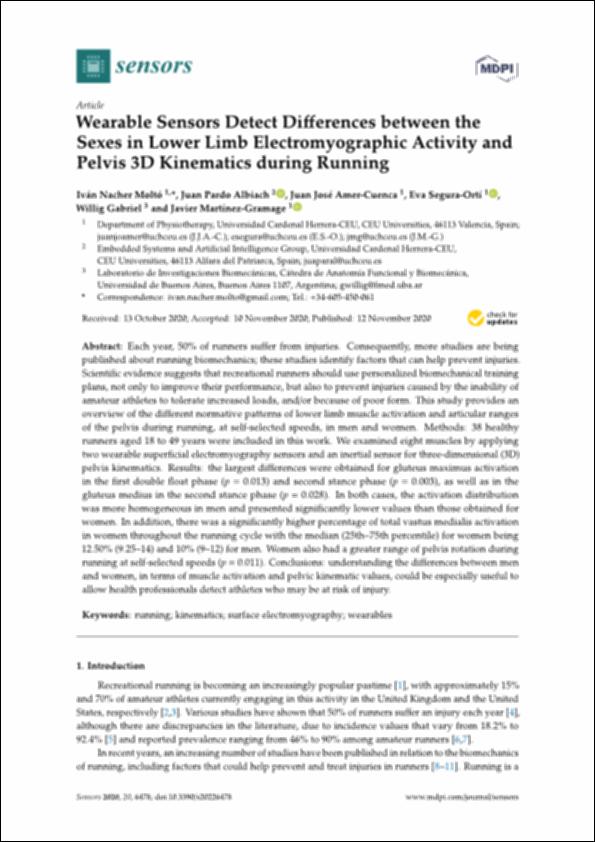Por favor, use este identificador para citar o enlazar este ítem:
http://hdl.handle.net/10637/12711Wearable sensors detect differences between the sexes in lower limb electromyographic activity and pelvis 3D kinematics during running
| Título : | Wearable sensors detect differences between the sexes in lower limb electromyographic activity and pelvis 3D kinematics during running |
| Autor : | Nacher Moltó, Iván Pardo Albiach, Juan Amer Cuenca, Juan José Segura Ortí, Eva Gabriel, Willig Martínez Gramage, Javier |
| Materias: | Extremidades inferiores - Músculos - Electromiografía.; Cinemática.; Athletics - Physiological aspects.; Biomecánica.; Biomechanics.; Extremidades inferiores - Propiedades mecánicas.; Leg - Mechanical properties.; Pelvis - Propiedades mecánicas.; Kinematics.; Pelvis - Muscles - Electromyography.; Leg - Muscles - Electromyography.; Pelvis - Músculos - Electromiografía.; Sistema musculoesquelético - Fisiología.; Musculoskeletal system - Physiology.; Pelvis - Mechanical properties.; Atletismo - Aspectos fisiológicos. |
| Editorial : | MDPI. |
| Citación : | Nacher-Moltó, I., Pardo-Albiach, J., Amer-Cuenca, J.J., Segura-Ortí, E., Gabriel, W. & Martínez-Gramage, J. (2020). Wearable sensors detect differences between the sexes in lower limb electromyographic activity and pelvis 3D kinematics during running. Sensors, vol. 20, i. 22 (12 nov.), art. 6478. DOI: https://doi.org/10.3390/s20226478 |
| Resumen : | Each year, 50% of runners su er from injuries. Consequently, more studies are being published about running biomechanics; these studies identify factors that can help prevent injuries. Scientific evidence suggests that recreational runners should use personalized biomechanical training plans, not only to improve their performance, but also to prevent injuries caused by the inability of amateur athletes to tolerate increased loads, and/or because of poor form. This study provides an overview of the di erent normative patterns of lower limb muscle activation and articular ranges of the pelvis during running, at self-selected speeds, in men and women. Methods: 38 healthy runners aged 18 to 49 years were included in this work. We examined eight muscles by applying two wearable superficial electromyography sensors and an inertial sensor for three-dimensional (3D) pelvis kinematics. Results: the largest di erences were obtained for gluteus maximus activation in the first double float phase (p = 0.013) and second stance phase (p = 0.003), as well as in the gluteus medius in the second stance phase (p = 0.028). In both cases, the activation distribution was more homogeneous in men and presented significantly lower values than those obtained for women. In addition, there was a significantly higher percentage of total vastus medialis activation in women throughout the running cycle with the median (25th–75th percentile) for women being 12.50% (9.25–14) and 10% (9–12) for men. Women also had a greater range of pelvis rotation during running at self-selected speeds (p = 0.011). Conclusions: understanding the di erences between men and women, in terms of muscle activation and pelvic kinematic values, could be especially useful to allow health professionals detect athletes who may be at risk of injury. |
| Descripción : | Este artículo se encuentra disponible en la siguiente URL: https://www.mdpi.com/1424-8220/20/22/6478 Este artículo pertenece al número especial "Wearable sensors & gait". |
| URI : | http://hdl.handle.net/10637/12711 |
| Derechos: | http://creativecommons.org/licenses/by/4.0/deed.es |
| ISSN : | 1424-8220 (Electrónico). |
| Fecha de publicación : | 12-nov-2020 |
| Centro : | Universidad Cardenal Herrera-CEU |
| Aparece en las colecciones: | Dpto. Enfermería y Fisioterapia |
Los ítems de DSpace están protegidos por copyright, con todos los derechos reservados, a menos que se indique lo contrario.


